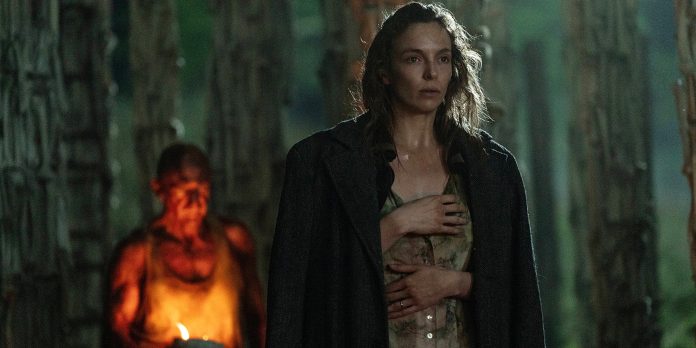THE STORY – A group of survivors of the rage virus lives on a small island. When one of the group leaves the island on a mission into the mainland, he discovers secrets, wonders, and horrors that have mutated not only the infected but other survivors.
THE CAST – Jodie Comer, Aaron Taylor-Johnson, Jack O’Connell, Alfie Williams & Ralph Fiennes
THE TEAM – Danny Boyle (Director) & Alex Garland (Writer)
THE RUNNING TIME – 115 Minutes
When “28 Days Later” first bowed on screens over two decades ago, you could immediately sense it made a bold entrance into the horror genre. It brilliantly took the conventions of a familiar landscape, the zombie apocalypse, and found inventive methods to infuse its story with a distinguished identity. The infected were still mindless hordes that were prone to attack but now possessed a newfound agility, propelling forward with an unrelenting speed that had never been seen before. The gritty aesthetics also were not attempted to be hidden; instead, the grungy cinematography underlined a world that had fallen into decay and created an even more realistic sense of intimacy. It’s a film that marked a statement for both director Danny Boyle and writer Alex Garland, and it’s a legacy that has endured despite only one attempted sequel in all this time. Now, that original creative team has reunited for “28 Years Later,” returning to a world full of terror and despair. What they provide now is a fascinating introspection that does suffer from a wildly erratic mixture of tones that has difficulty settling into a satisfying rhythm.
As was the case since the first film, the world is still reeling from a deadly and highly infectious virus that has run rampant through the population, turning those who are diseased into raging monsters that seek to kill any life they stumble across. This contagion has mostly been confined to the British Isles, where pockets of survivors have managed to live out relatively peaceful lives in complete isolation. In one of these tucked-away villages, Jamie (Aaron Taylor-Johnson) is raising his twelve-year-old son Spike (Alfie Williams) to protect himself from the dangers that surround their small community. Spike’s curiosity about the outside world is piqued even more when he believes there may possibly be an answer to help his ailing mother, Isla (Jodie Comer). She’s been suffering through bouts of erratic behavior, and Spike is desperate to help her. When he learns of a doctor who might be living out in the forest, he slips away from his disapproving father and embarks on a journey with his mother to get the help she needs. Their venture will cross paths with many of those inflicted with this virus, including some that are formidable opponents that have never been seen. But they will also discover an inner truth that potentially speaks to a more potent message from within.
This project seems to be a shot of creative adrenaline for both Boyle and Garland, though the former has spent more time in the wilderness with lackluster efforts like “T2 Trainspotting” and “Yesterday.” That particular enthusiasm for propulsive filmmaking that splashed the screen with a vibrant, chaotic energy has indeed roared back after laying dormant for so many years. From the very opening frames, the wildly energetic editing returns, putting us back into the frenzy that occurs when these demons attack and all hell breaks loose. It’s also present in Anthony Dod Mantle’s cinematography, which again opts for consumer-grade equipment but can capture explicit imagery with modern iPhones. The presentation of the violent kills features a novel approach, often playing with perspective and frame rates to make a more impactful moment. Sometimes, these decisions come across as stylized merely for the sake of being so, but there’s no denying the unique methodology being attempted. That deserves recognition in the same way the original film pioneered so many years ago.
What’s more fascinating, or perhaps frustrating as a more accurate term, is how Garland’s screenplay aims to deepen this established world. While there have been emotional arcs that were undercurrents of both previous films, the showcase here is much more naked in its ambitions. Those are actually the strongest elements of his narrative. Wrapped within a story of a small group of people attempting to survive an apocalypse is a moving story about a son and his mother. Not only that, but it is a profoundly moving examination of death, coming to terms with its inevitability while embracing the treasured life that is left behind. When Spike and his mother meet the doctor, played by Ralph Fiennes, the film’s breakneck pack suddenly halts. Instead of becoming tedious, it actually transforms into a more poignant examination, recognizing that the mass destruction has not erased the profound loss. It’s a moving sentiment, beautifully rendered through Boyle’s direction, that taps into a spiritual component that makes these themes resonate even deeper.
However, these beautifully rendered moments of intense catharsis don’t always mesh well with the overt horror elements at play. A jarring sense of whiplash occurs when a tender sequence of emotional outpouring is immediately followed by a tense scene of characters hiding from a raging monster. It’s not to say the latter is entirely ineffective, but it comes out of more obligation than natural narrative progression. It feels as if Garland has fashioned an engrossing portrait of a life that attempts to carry on in the face of unrelenting trauma that has captivating layers of introspective commentary. These aspects are forced to contend with the more basic requirements of the franchise, and pretty soon, the diminishing returns affect the tedious chase scenes and lackluster supporting players. A new antagonist is introduced in the form of an “alpha” infected, equipped with seemingly supernatural abilities of strength and intellect, but also comes across more like a video game boss that needs to be occasionally defeated before moving on to the next plot point. The results are still engaging, but there’s a tug-and-pull between a more original concept about inner turmoil that is forced to contend with genre conventions that the final product feels less interested in displaying.
Even though this film has plenty of well-known faces among the cast, the true lead here is Williams. His credits may be few, but he takes on an impressive task of carrying this story. His presence captures the realistic quality of a child in unusual circumstances. He has weaknesses and deficiencies but acts out in ways that are believable, even in this extraordinary situation. There is no sense of pretense in his performance, and he always communicates a grounded reality that is quite effective. The same goes for Comer, who, in tandem with Williams, provides the most resonant emotional journey that is the most impassioned. Fiennes is also a surprisingly compelling figure whose first appearance suggests a more histrionic personality that instead appeals to more tender sensibilities. Taylor-Johnson provides another reliable turn that isn’t all that impactful but is sturdy enough for what he’s given. Those expecting to see more Jack O’Connell after his fantastic portrayal in “Sinners” will be disappointed by how little he features, only showing up in the finale as a means to indicate the continuing chapter. It’s a fun bit only here to promise more for the future when Nia DaCosta’s sequel, “28 Years Later: The Bone Temple,” releases in January 2026.
That abrupt ending to “28 Years Later” actually does catch one off-guard. The pacing at the beginning can be rather choppy, especially with Boyle indulging in more experimental choices, such as intercutting the recording of Rudyard Kipling’s poem “Boots” with older archival footage depicting scenes of war. It’s an interesting callback to the “people killing people” observation of the first film, but it does hamper the natural rhythm of the storytelling. However, once through that section, the film moves along at a steady clip, investing in this world and these characters to a gratifying conclusion. The last five minutes essentially play as a cliffhanger to tune into the next episode, which is a jarring finale. Maybe that’s emblematic of the messy collage the film presents. Its thematic commentary becomes so strong in many sections that it actually undercuts the horror set pieces. Boyle’s exuberant filmmaking and Garland’s incisive script sometimes clash when forced to muddle through laborious exercises that feel borrowed from the previous films anyway. It’s a scenario that reminds me of Ridley Scott’s “Prometheus” and “Alien: Covenant,” two films with intriguing ideas that struggled to fashion them within the framework of the established franchise. Perhaps the continuation will find more clever avenues to explore further and enrich this text. As is, what is left is imperfect but still an enthralling return into a dark but provocative world.


